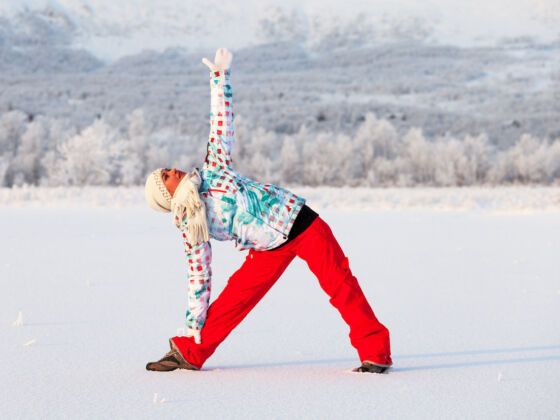Like climbing gyms, many winter resorts are catching on to yoga’s usefulness in preventing injury and combating muscular imbalances in skiers. As we’ve discussed in previous articles increasing your range of motion can help prevent injury, especially in sports like skiing, where awkward slips and twists are common causes of injury.


Below are some yoga poses to help increase your hip mobility and improve your turning, undo lower-body versus upper-body asymmetries, and help you stay centered on your skis, even when standing still.
Use these poses to warm up and cool down as well; if anything, it’ll give you an excuse to hang out in the lodge that much longer.
(Note: The images do not necessarily correlate with the yoga poses listed. Click on the hyperlinks for Yoga Journal’s expert photos.)
1. Tadasana / Mountain Pose
Benefits: An active posed disguised as a passive one, the entire body is engaged in order to help you find your center of balance while standing, while strengthening the the ankles and arches of the feet.
How: Stand straight up with your hands and arms engaged so that the shoulders are moving away from the ears, your spine is long and straight (no arched back), and the inner sides of your feet are touching without the ankles rubbing against each other. Lift your toes, so that your arches lift up, and try to keep that same feeling when you place your toes back down.
Engage your quadriceps slightly too, and hold the pose for 60 seconds. Repeat one to two more times. Try holding your arms straight up overhead and pressing the palms (Urdhva hastasana / upward salute) as a way of changing it up.
2. Utkatasana / Chair Pose
Benefits: Strengthens the core and the knee joints, and is even more intense than mountain pose for training your upright balance. Utkatasana mimics the posture of skiing without the danger of falling, so this is the perfect strengthener for the legs and related muscles.
How: From Tadasana, bend your knees deeply and drop your tailbone towards the floor. Suck in your stomach and reach your arms overhead, palms facing each other, pulling your shoulders away from your ears. Look up towards the ceiling and breathe deeply while holding for 30-60 seconds. Repeat two more times.
3. Utthita Hasta Padangustasana / Extended Hand-to-Toe Balance Pose
Benefits: A super-intense balance pose that also strengthens all the small tendons and muscles that support your ankles, knees, and hip joints. Use a belt as a prop and a wall for support if necessary. This pose should be done after warming up the body.
How: From Tadasana, straighten your left leg without locking the knee. As you inhale, put your left hand on your hip and lift your right leg up, grabbing the toe with your right hand (use a belt if you have tight hamstrings). Keep your back and left leg straight as you suck in your stomach and extend your right leg in front of you without straining your hamstring. Hold for five long breaths, then swing the right leg to the right, and hold there for five breaths.
Bring the leg back in front of you, and release and point the toe, keeping your leg lifted as much as you can for five breaths. Lower the foot to the floor. Repeat on the left side.
4. Purvottansana / Upward Plank Pose
Benefits: This helps realign the spine and strengthens the arms, wrists, and legs, helping to combat muscular imbalance.
How: Sitting on the floor with your legs extended in front of you, walk your hands about six to eight inches behind your hips. Place your palms on the floor with your fingers and thumbs directed towards your hips. Plant your feet and lift your hips towards the ceiling, so that your shoulder blades meet.
Keep your chest open and, gazing at the ceiling, walk your feet away from you while keeping your hips at the same height. If you can straighten your legs, press your big toes to floor and breathe for 30 seconds. Lower down to the floor. Repeat one to two times.
5. Marichyasana A / Sage Marichi Pose
Benefits: Stretches and strengthens the spine and shoulders, which helps with muscular imbalances and strengthens the legs and hip joints.
How: Sitting on the floor, with your legs extended in front of you, bend the left knee and plant the foot as close the sitting bone as possible with some space between the foot and your right thigh. Flex your right foot, and hug the left shin into the body as you reach over the right leg (use a belt if you can’t reach your foot). Keep the bent knee upright as you fold deeper with every exhale.
If you can wrap your left arm around your left shin and bind your hands behind your back, go for it. Hold for 20-30 seconds on each side.
6. Supta Baddha Konasana / Goddess Pose (Don’t worry, men, it works just as well for you.)
Benefits: This is a lovely restorative pose after being upright all day, and will help relieve hip tightness from all that forward motion and turning during your ski session.
How: Sitting up, fold your feet in and let your knees fall to the side, as if you’re in a “butterfly” stretch. Placing a cushion under your lower back for support (and maybe one under each knee if you have tight hip flexors), keep the soles of your feet touching as you lie down and let your arms fall to the side. Breathe there for five minutes, and come out of the pose slowly.
Community Connection
Learn how to make your own skis at mSports.
Feature Image by Zach Dischner